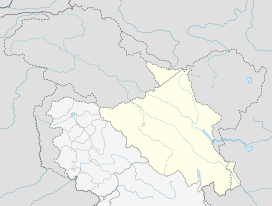Hot Springs, Chang Chenmo Valley
Hot Springs (Kyam[1]) is the location of an Indian border checkpost operated by Indo-Tibetan Border Police (ITBP) in the Chang Chenmo River valley in Ladakh near the disputed border with China. It is so named because there is a hot spring at this location.[1] The Line of Actual Control near Kongka Pass is only 3 kilometres (2 mi) to the east.[2]
Hot Springs | |
|---|---|
Border checkpost | |
 Hot Springs  Hot Springs | |
| Coordinates: 34.30°N 78.95°E | |
| Country | |
| Union Territory | Ladakh |
| District | Leh |
In Autumn 1959, the Kongka Pass incident occurred near here. At the time, the Central Reserve Police Force (CRPF) personnel[lower-alpha 1] were given the mandate of constructing this camp.[2] During the construction, the scouting team was captured by the PLA who had advanced to Kongka Pass since the previous years. On 21 October, the search team tasked to find the missing scouts encountered the Chinese and were caught in a firefight that led to the death of 10 members.[4] They have been since honored as martyrs by the law enforcement in India annually on this day. In the 1960s, a Police Memorial was erected here at Hot Springs.[5]
Historically, the name for the hot spring was Kyam[1] (Kiam, Kayam[4]). The Chinese still refer to it by this name.[6] It is also associated with Gogra[7] which is actually the location of a campsite at a river junction a short distance to the northwest.[8][9] In the late 1800s, the Maharaja Ranbir Singh at the request of the British made improvements to the trails and facilities of the Gogra campsite in order to improve trade with Yarkand.[10] The valley was also a popular hunting spot for British officers on leave.[9][11]
See also
- Konga Pass
Notes
Footnotes
- The units manning the post were called "Indo-Tibetan Border Force" but they were regular members of the CRPF.[3] The present Indo-Tibetan Border Police was raised later in 1962.
References
- Geological Survey of India (1883). Memoirs of the Geological Survey of India. order of the Governor-General of India. p. 44.
Gogra and Kyam. In the Changchenmo valley near the halting place Gogra (Gokra) and Kyam (Kium) hot springs are numerous. ... The spring at Kyam has a temparture of 147° F.
- Jindal, Akash (November–December 2018). "The Story of Hot Springs" (PDF). Indian Police Journal. No. Special Issue on Police Martyrdom. pp. 20–33. ISSN 0537-2429. Retrieved 4 January 2020.
(p22) Karam Singh of ITBF was assigned the task of establishing outposts near the Chinese Occupation Line ... “Hot Springs” was barely three Km far from the site where Chinese Army had intruded.
- Martyrs of CRPF, police.gov.in (Indian Police web site), Retrieved 29 January 2020.
- "Notes, Memoranda and letters Exchanged and Agreements signed between The Governments of India and China" (PDF). White Paper III. Ministry of External Affairs, Government of India. November 1959 – March 1960. Retrieved 4 January 2020 – via Claude Arpi.
[Chinese interrogation of Karam Singh] We established a checkpost at Kayam and we had to establish one at Shamul Lungpa. On 20th October, 1959, our two men missed. On the morning of 21st October 1959 Tyagi took 60 men and reached the hill (battle field). ... [Indian debriefing of Karam Singh] we had inadequate cover and the Chinese were in a favourable position ... five of us were made to carry the dead body of a Chinese soldier who had been killed.
- Bhatnagar, R.R. (November–December 2018). "Hot Springs: Saga of Heroism" (PDF). Indian Police Journal. No. Special Issue on Police Martyrdom. pp. 14–19. ISSN 0537-2429. Retrieved 4 January 2020.
(p17) Ceremonial Homage being paid at Hot Springs Memorial in 1960’s (p18) The day 21st Oct is befittingly observed as “Police Commemoration Day” and every year, members of police forces from different parts of the country trek to Hot Springs which is currently manned by ITBP to pay homage to the brave hearts who made the supreme sacrifice on 21st October 1959.
- "中华人民共和国外交部给印度驻华大使馆的照会(1965年9月16日)" [Note by the Chinese Foreign Ministry to the Indian Embassy in China (16 September 1965)] (in Chinese). RedChinaCn.net. 16 August 2017. Retrieved 4 January 2020.
基阿姆温泉建立哨所
- Sharma, Vinita; Raza, Mohd.; Ahmed, Khursheed; Nigam, Parag; Khan, AnjaraAnjum; Sharma, ChandraPrakash; Sharma, Vipin; Goyal, SurendraPrakash (2016). "OPPORTUNISTIC OCCURRENCE, SIGNIFICANCE AND CONSERVATION IMPLICATIONS OF TRICHO-MORPHOMETRICS: LARGE WILD HERBIVORES OF CHANG CHENMO VALLEY, LADAKH, INDIA". International Journal of Advanced Research. 4 (12): 980–988. doi:10.21474/IJAR01/2483. ISSN 2320-5407.
Figure 1. Gogra
- Ward, A.E. (1896). The Tourist's And--sportsman's Guide to Kashmir and Ladak, &c. Thacker, Spink. p. 106.
The Changlung stream joins the Kugrang near Gogra
- Hayward, G. W. (1870). "Journey from Leh to Yarkand and Kashgar, and Exploration of the Sources of the Yarkand River". Journal of the Royal Geographical Society of London. 40: 33–37. doi:10.2307/1798640. ISSN 0266-6235.
(p33) 'Kiam' and 'Gogra' located near bottom of last map insert ... (p37) Chang Chenmo is now well known, being visited every year by at least half-a-dozen officers on long leave to Kashmir. The game to be found...
- Accounts and Papers. East India. XLIX. House of Commons, British Parliament. 1874. pp. 23–33.
(p23) From Gogra there are two routes to Shadula in Yarkand (p33) Every endeavour has been made to improve the Changchenmo route--serais having been built at some places, and depots of grain established as far as Gogra
- H.I.N. (1902). "Sport in the Changchenmo Valley, Ladakh". The Navy and Army Illustrated. Vol. 15. London: Hudson & Kearns. p. iv.